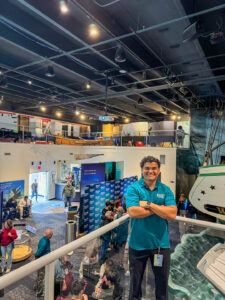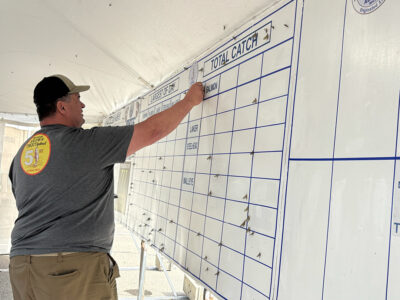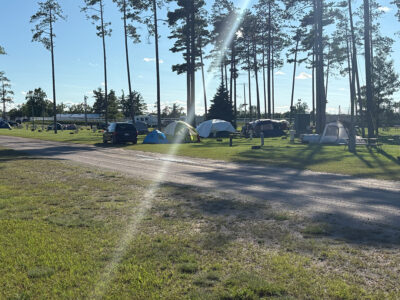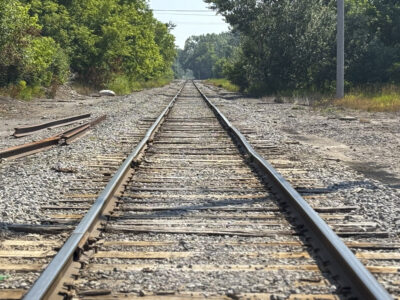‘Thanks, but no tanks’
Freedivers go deep, sans bulky equipment

Courtesy Photo by Dan Kelly Freediving instructor Mark Lozano checks his dive computer near the bottom of the Middle Island Sinkhole.
ALPENA — A heavy tank can not only weigh a diver down, but the bubbles can scare away fish and other underwater creatures. That’s just one reason why Mark Lozano prefers freediving over scuba.
“As freedivers, we don’t have gauges … to tell us how much air we have left,” he said. “We have to rely on our body. So it really, kind of, turns into a lifestyle for people that take it seriously.”
Although he is scuba certified, he has been exclusively freediving since 2009.
“A lot of people think that the breath hold is the hardest part of freediving, but it’s actually not,” said Lozano, who is in Alpena this weekend teaching a Freediving Instructors International Level One Freediver course. “Equalizing is the hardest part of freediving.”
Equalizing is essentially relieving the water pressure that has bent the ear drum inward as the air in the middle ear compresses. It is basically “popping” your ears, and failure to do so can cause harm to the delicate mechanisms of the ear.

News Photo by Darby Hinkley Freediving instructor Mark Lozano, of San Francisco, is in Alpena teaching freediving classes this weekend.
He said hydration is key, as well as diving with a buddy, because most safety issues can be handled quickly as long as someone else is there to offer or call for help.
“The course consists of teaching basic freediving safety as well as teaching people technique: breathhold techniques, diving/water entry techniques, how to hold their breath for extended periods of time, over three minutes for some people, to a maximum depth of up to 66 feet out in the open water,” Lozano explained.
Lozano, of the San Francisco Bay area, has been freediving for about 23 years. In that time, he has completed dives all over North America, including Alaska, Hawaii, California, Mexico, Montana, Utah, Michigan, Florida, Texas and more. He has also completed dives in Qatar and Iceland.
Lozano’s deepest freedive to date is 170 feet. Prior to achieving that depth, Lozano trained for about six months in south Florida with then-world-record holder Martin Stepanek, who founded Freediving Instructors International.
“I trained with him for about six months, and I brought that back to the west coast, where I’m from, and back in 2009, I was the first and only accredited freediving instructor on the west coast of the United States,” Lozano said.

News Photo by Darby Hinkley Maritime Archaeologist Stephanie Gandulla talks about some of the equipment freedivers use, such as masks and fins, but no oxygen tanks, at Great Lakes Divers, an Alpena shop owned by her husband, Nick Myers.
Lozano’s personal best breath hold is six minutes, he said, adding that he certainly can’t do that every time he dives.
“Your physiology changes every day,” he said.
The diving class will meet today at the Alpena Plaza Pool to start training, Lozano said. Then on Sunday they will head out to the open waters of Lake Huron. This is his fifth time visiting Alpena, where he enjoys diving in the Thunder Bay National Marine Sanctuary.
“Lake Huron, and sanctuary water in particular, is a great place to freedive,” said Nick Myers, spearfisherman and owner/operator of Great Lakes Divers in Alpena. “You really have a huge selection of sites, depending on your skill level or just what you feel like seeing. There are historic sites, from shallow to 30 meters plus. There are also geological sites like the sinkholes and cliffs and places where you can see a lot of aquatic life. If you’re into spearfishing, there are plenty of fish we can hunt, too. The freediving and spearfishing community in the Great Lakes is small, but growing, and most people are happy to help new divers get into the sport.”
TBNMS Maritime Archaeologist Stephanie Gandulla explained that freediving is an ancient practice.
“In Japan, older women are still harvesting abalone freediving,” she said. “Freediving has been around forever.”
She added, “It really allows you to be more in tune with your physiology, but also, more in tune with your environment.”
“We like to say, ‘Thanks, but no tanks’,” Lozano said. “Because if you watch a scuba diver at the end of a dive, they’re always getting out and they’re like,” (he moved like a gorilla in slow motion emerging from the water, breathing heavily with every belabored step). “And then you watch a freediver get out, and they’re like,” (he sprung from the imaginary lake wearing a huge smile) “‘Oh, man, that was such a great dive!'”
Not wearing bulky gear makes it a more natural interaction with underwater surroundings, including shipwrecks in the sanctuary. You can also fly on a plane after freediving, whereas you have to wait 24 hours after scuba diving, he said, because the elevation change can cause the bends.
“I’ve gotten to dive with all different kinds of sharks, humpbacks and killer whales — orcas,” Lozano said. “I started out spearfishing, and it’s turned into more like, ‘Let’s just enjoy what’s down there.'”
- Courtesy Photo by Dan Kelly Freediving instructor Mark Lozano checks his dive computer near the bottom of the Middle Island Sinkhole.
- News Photo by Darby Hinkley Freediving instructor Mark Lozano, of San Francisco, is in Alpena teaching freediving classes this weekend.
- News Photo by Darby Hinkley Maritime Archaeologist Stephanie Gandulla talks about some of the equipment freedivers use, such as masks and fins, but no oxygen tanks, at Great Lakes Divers, an Alpena shop owned by her husband, Nick Myers.








